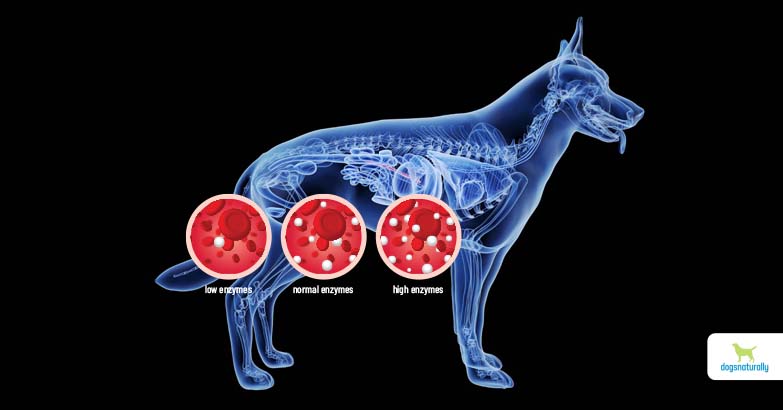Organs are the multi-vitamins of your dog’s diet. They’re a natural source of vitamins and minerals.
But organs also have one very unique benefit …They can help strengthen and repair your dog’s organs.
So feeding your dog pancreas can help support his pancreas in 5 powerful ways.
Read on to learn more about pancreas for dogs …
One Organ: Two Functions
The pancreas sits close to your dog’s stomach … this is because it’s very involved in your dog’s digestion. But the pancreas is an organ with two very different functions:
Exocrine Function
Most of the pancreas (95%) is made up of exocrine tissue. This is specialized tissue that excretes enzymes to help your dog digest his food. The pancreas produces three main digestive enzymes:
- Amylase to digest carbohydrates
- Lipase to digest fat
- Protease to digest protein
These enzymes break foods down into smaller units that can be used for energy and cell repair.
RELATED: When to give your dog digestive enzymes …
Endocrine Function
The pancreas also produces hormones, which makes it an endocrine gland.
The pancreas produces 10 different hormones. The two most important ones are insulin and glucagon. Insulin lowers glucose levels, while glucagon raises it.
Now that we know more about the organ that does double duty, let’s take a look at why it’s important to feed this organ to your dog …
Top 5 Reasons To Feed Pancreas
1. It Supports The Pancreas
In 1899, the Merck Manual was one of the very first professional books used by veterinarians. Over 100 years ago, it recommended using pig pancreas to support the pancreas. This is called glandular therapy.
Although it’s been mostly forgotten by modern medicine, glandular therapy is still widely recognized as an effective treatment. This is because each organ carries unique nutrients and fats needed for optimal functioning. For example, the brain is rich in DHA, a fatty acid that protects nerve cells. And the pancreas is rich in digestive enzymes and hormones.
Dogs with a poorly functioning pancreas will have trouble producing enough digestive enzymes to digest their meals. If left unchecked, this can lead to nutritional deficiencies.
The dogs most at risk for enzyme deficiency include:
- Senior dogs
- Dogs eating kibble or cooked food
- Dogs with pancreatitis
- Dogs with EPI
It can also help balance the hormones in diabetic dogs.
RELATED: If your dog’s not eating these organs then he’s missing out …
2. It May Help Control Pancreatitis
Pancreatitis means inflammation of the pancreas. The pancreas is an organ that is a bit sensitive … it can be stressed by drugs, toxins, poor diet or an excessively fatty diet.
An inflamed pancreas will start to form scar tissue. Eventually, this can block the cells that produce insulin and glucagon, as well as the cells that produce digestive enzymes.
Breeds predisposed to chronic pancreatitis include:
- Yorkshire Terriers
- Cocker Spaniels
- Cavalier King Charles Spaniels
- Collies
- Boxers
- Miniature Schnauzers (who have issues with fat metabolism)
Dogs with pancreatitis can benefit from eating pancreas because it will provide the digestive enzymes and hormones that the pancreas can no longer sufficiently produce.
RELATED: Pancreatitis in dogs: The scary truth & how to manage it …
3. Pancreas Helps With EPI
EPI is exocrine pancreatic insuffiency. It means the pancreas doesn’t produce the enzymes needed to break down fat, protein and carbohydrates in food. So your dog’s body can’t absorb nutrients.
Untreated EPI can lead to organ failure and can be deadly. .
Conventional Vets Like It Too!
Even conventional veterinarians recommend feeding pancreas for EPI dogs.
One study showed that feeding pancreas controlled EPI dogs’ symptoms. In fact, their general health reached that of normal dogs in the study within four months.
Feed your dog pancreas or add pancreatic enzymes to food. That replaces those missing enzymes and helps your EPI dog absorb nutrients.
RELATED: EPI and other digestive diseases in dogs …
4. It’s Proactive Against Diabetes
When insulin isn’t produced, glucose builds up and your dog can become diabetic.
Type 2 diabetes is the most common in people – and it’s also the type of diabetes that cats get. But most diabetic dogs have type 1 diabetes. And it’s a lot more serious.
When the pancreas doesn’t produce insulin properly, glucose can’t get into the body’s cells. Diabetic dogs usually need lifelong treatment with insulin shots. Preventing diabetes in dogs is extremely important.
Type 1 diabetes is not caused by diet – but diet is a huge factor in preventing and managing it.
There are many nutrition related factors that can cause diabetes:
- Food allergies
- Inflammatory ingredients
- Contaminants (drugs, toxins and other endocrine-disruptors)
- Weight (fat cells secrete pro-inflammatory messenger molecules and hormones)
- Diet-related pancreatitis
According to the Washington State University College of Veterinary Medicine, “Animals that are overweight or those with inflammation of the pancreas are predisposed to developing diabetes. Some drugs can interfere with insulin, leading to diabetes.”
About 25% of diabetic dogs have or have had pancreatitis. This destroys beta cells in the pancreas … beta cells are the ones that produce insulin. So, feeding pancreas is a proactive step that may help prevent diabetes. Here’s how it works …
Pancreas contains manganese. This mineral helps insulin production for blood sugar control. And pancreatic enzyme provide efficient digestion of fat, protein and carbohydrates. This reduces the burden on a compromised pancreas and allows the pancreas to produce insulin as it should.
RELATED: What causes diabetes in dogs?
5. Pancreas Provides Enzymes For Older Dogs
As your dog ages his body produces fewer enzymes. It’s a natural progression. Your dog’s body can’t keep up! This means all senior dogs are likely to have an enzyme shortfall.
But younger dogs can have a deficiency too. They benefit from having digestive enzymes added to their diet.
Poor diet, drugs, city water, vaccines as well as aging can all deplete your dog’s enzyme supply.
Enzyme deficiencies can affect vital processes in your dog’s body, like …
- Immune system
- Waste and toxin elimination
- Hormone regulation
- Gallbladder function
Dogs with food intolerances, allergies, recurring ear infections or skin problems can be helped by digestive enzymes. Most of these problems are symptoms of poor gut health.
Feeding pancreas can provide your dog with the enzymes he needs.
Here’s how to go about adding pancreas to your dog’s diet.
How To Feed Dogs Pancreas
If you’re wondering about fresh raw pancreas vs powdered … research shows that both forms are effective. And you only need a little.
When feeding powdered pancreatic enzymes, ensure the product is freeze-dried. Heat destroys enzymes so don’t use a product that’s been dehydrated.
Dosing: Buy a product made for dogs and follow the product directions. If you buy a product sold for humans, assume dosing is for a 150 lb person and adjust for your dog’s weight.
Or, if you want to feed raw pancreas to your dog … 1 to 3 ounces (30-90 g) of chopped pancreas replaces one teaspoon of powdered pancreatic extract.
Feeding pancreas is definitely a good thing for your dog. Its digestive enzymes help pets digest food better … and that means any food. It increases digestion of protein, fats and carbohydrates.
Make It Part Of The Regular Diet
As part of the regular diet for a healthy dog, feed pancreas along with heart, lungs, liver, brains, spleen… Use a variety of organs to make up 25% of your dog’s diet. After all, organs account for 25% of your dog’s body so organs should be 25% of his diet.
Fresh pancreas can be chopped and added to food along with other organs. It may be a little harder to come by than liver, heart and kidney. When you have it, chop it and freeze it in ice cube trays or small bags so you have it handy to add to the mix. It will keep in the freezer for about 3 months.
How To Feed Dogs With EPI Or Pancreatitis
If your dog suffers with pancreatitis or EPI, feed as follows:
Raw Pancreas
- 2 ounces of raw beef pancreas for every 20 lbs of body weight, divided between two meals
- Do not feed more than 2 ounces twice daily
- Example: 60 pound dog/20 = 3 x 2 = 6 ounces of beef pancreas daily
Powdered Pancreas
- Initially, two teaspoons per 20 kg body weight per meal.
- Powders are preferable to tablets so they can coat the food better.
- Many experts recommend “incubating” the powder. This means you add it to your dog’s food, moisten the powder, and let it sit at room temperature for 20 to 60 minutes before feeding. Otherwise the enzymes can cause mouth bleeding or sores. If that happens, reducing the dose usually resolves the problem.
When you’re feeding pancreas therapeutically as prescribed, you can gradually decrease the amount fed as symptoms fade.
Tips to Remember:
- You only need to add a little
- Frozen pancreas has a 3-month freezer life
- You can feed raw or frozen pig, beef or lamb pancreas or freeze-dried powdered supplement
- According to the Merck Veterinary Manual, 1 to 3 oz of raw pancreas can replace 1 teaspoon of enzyme powder
- Raw pancreas is best fed at room temperature to keep the enzyme action stable
Grass-fed Is Best
Like any food for your dog, find the freshest, best quality raw pancreas. Grassfed meat of any kind is always better.
Grass-fed meat has a higher amount of omega-3 fatty acids that fight inflammation. It also helps balance out the levels of omega-6 fatty acids. And it won’t contain antibiotics or hormones.
Where to Find Pancreas
If you’re looking for raw, there are online raw companies that sell pancreas alone or in blends. If you have a local abattoir or slaughterhouse, get to know them. Most organs don’t make it to your local butcher, but you’ll get good deals if you go right to the slaughterhouse.
There are also many retail and online providers that sell powdered organs … pancreas specifically. Others sell organ blends in dried format.
Pancreas is a superhero organ — a win-win in your dog’s diet at any time. And remember … with all the superpowers of the pancreas, he only needs a little to make a big improvement.
References
Wiberg ME et al, Response to long-term enzyme replacement in dogs with exocrine pancreatic insufficiency. Journal of the American Veterinary Medical Association. 1998 Jun 30;213(1):86-90.
Howell E. Enzyme Nutrition: The Food Enzyme Concept. New Jersey: Avery Publishing Group, 1985
Howell E. Food Enzymes for Health & Longevity. Lotus Press. 2014.
Goldstein, Martin DVM. The Nature Of Animal Healing. Random House 1999.
Villaverde C et al. Effect of enzyme supplements on macronutrient digestibility by healthy adult dogs. J Nutr Sci. 2017; Apr 18;6:e12.
Watson P. Chronic pancreatitis in dogs. Top Companion Anim Med. 2012 Aug;27(3):133-9.
Paula Jo (PJ), Broadfoot DVM. Digestive Enzymes In Dogs And Cats. Innovative Veterinary Care. 2018 Jun 13.
Jean Hofve DVM. Digestive Enzymes. Innovative Veterinary Care. 2013 Feb 20.
Timoleon S, Rallis DVM PhD et al. Exocrine Pancreatic Insufficiency In Dogs And Cats: An Update. WSAVA World Congress Proceedings 2004.
Gabriele M, Rutz DVM et al. Oral bleeding associated with pancreatic enzyme supplementation in three dogs with exocrine pancreatic insufficiency. Journal of the American Veterinary Medical Association, 2002 Dec 15;221:2.












